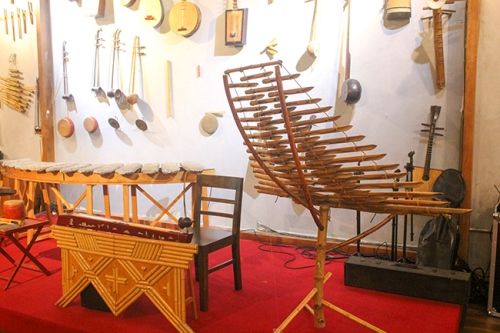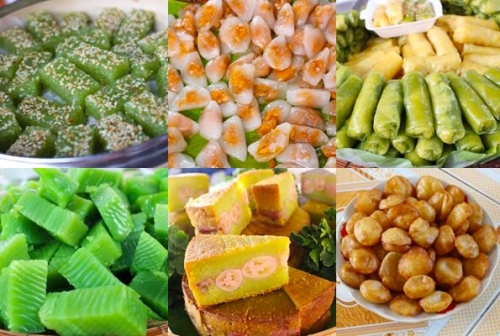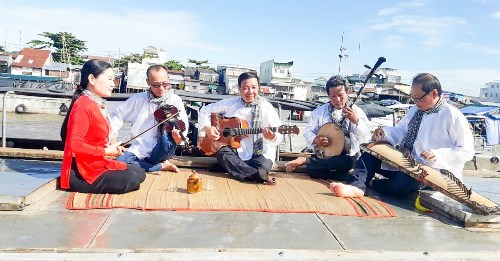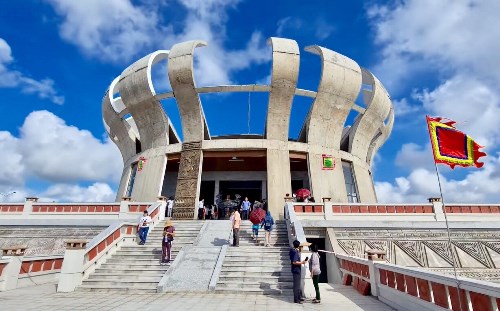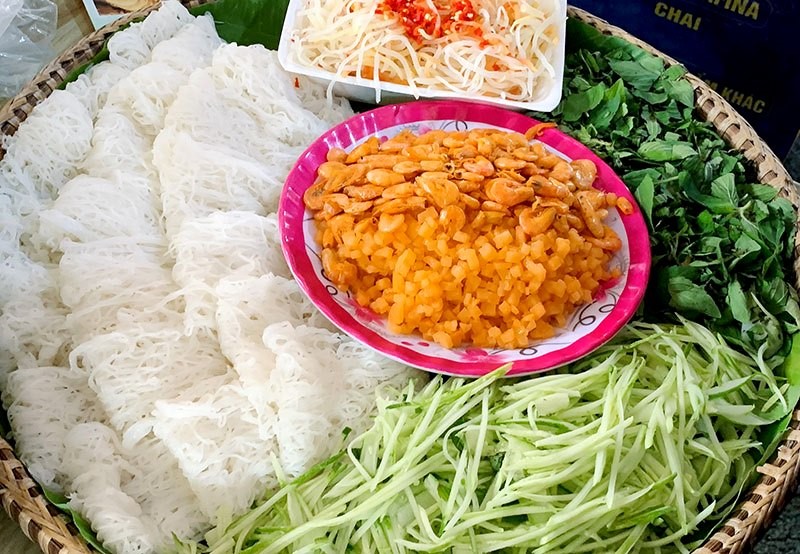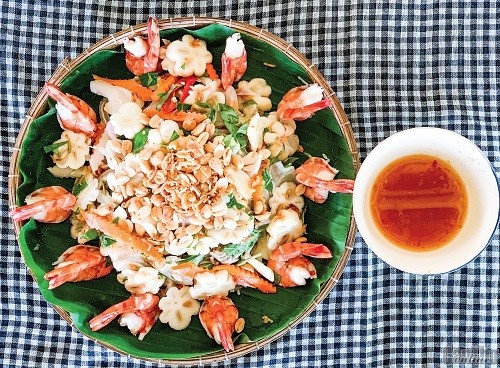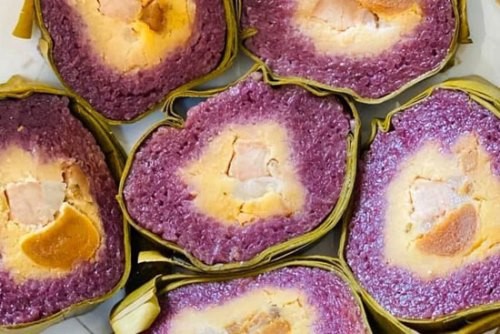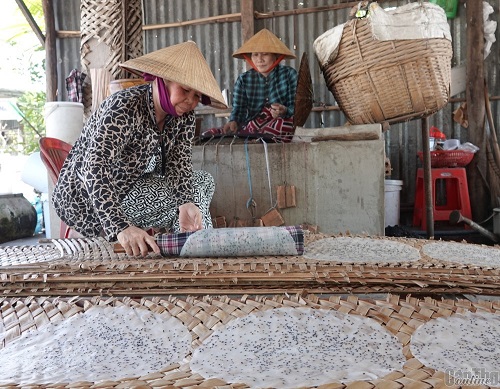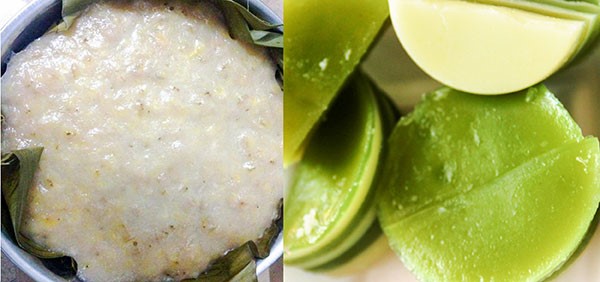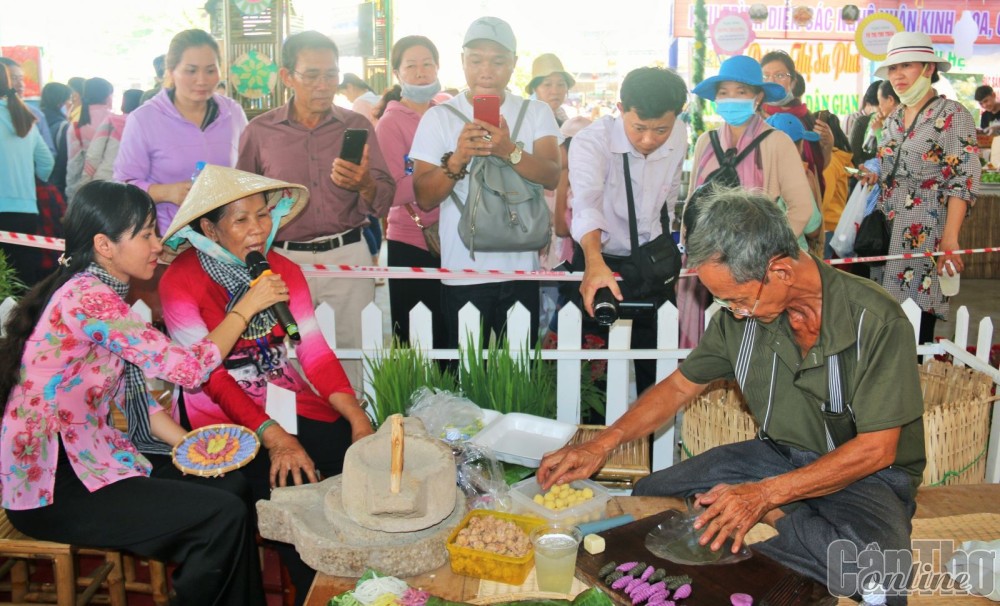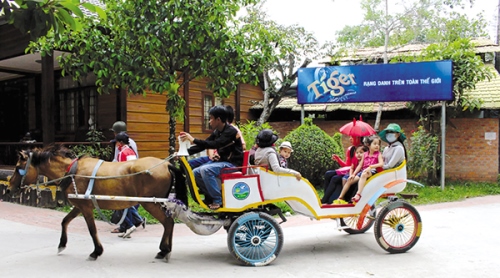
Horse Carriages – xe thổ mộ (grave-shaped carriages)
Each region gave the carriage a different name. It was called xe thổ mộ (voiture trainée par un cheval_a cart dragged by a horse) by the Saigon - Gia Dinh people and xe ngựa (voiture à cheval_a horse carriage) by the Western Southerners. However, the Geography of Can Tho says, “The most common kind of carriage in Can Tho was xe thổ mộ, which had two wheels and was pulled forward by physical power; it could carry several customers and goods conveniently” (2). Interestingly, nearly a hundred years ago, the word “xe” (a Vietnamese quantifier for a transport on land) was unknown to people in Bay Nui area of An Giang Province, so they used the verbal expressions “đi ngựa” (going by horse), “đi bò” (going by ox) instead. Later, the carriage developed in increasing numbers, so the locals started to use the noun xe ngựa (horse carriage).
Xe thổ mộ is a horse-drawn cart which was derived from a French-styled phaeton (voiture à deux cheveaux). It was modified to suit the local geography and habits. Once in Saigon, poet Tan Da liked the carriage very much, so he rented it for VND 2 per hour to ride his family for sightseeing. He writes, “Sài Gòn nhớ vị cá tra / Cái xe song mã chén trà Nhất Thiên” (3) (I miss the pangasius catfish taste in Sai Gon, its 2-horse-drawn cart and Nhat Thien tea) (3). In 1918, when going to the South, poet Pham Quynh also travelled by a carriage once.
Until now, there have been a lot of arguments about the origin of thổ mộ. According to author Vuong Hong Sen in “Tự vị tiếng nói miền Nam”, “Thổ mộ is a horse-drawn cart carrying goods and passengers in the outskirts of Saigon – Cho Lon - Lai Thieu, etc. Especially, due to its cambered covering, it was said to be call “boite d'allumettes” (matchbox)” by French colonists. However, other authors believed that it looked like a turtle shell or a grave, so it was called xe thổ mộ. The word “mộ” (grave) was associated with bad luck, so the locals often called it xe ngựa (horse carriage).
Can Tho, a Time of Horse Carriages
The Geography of Can Tho describes, “In 1930, in some markets like Binh Thuy, Cai Rang around Can Tho Province, popular means of transport were mainly carriages, oxcarts and trailers”. Carriages appeared in Sai Gon, in 1920 and became popular in the six provinces of Southern Vietnam in 1930. When Can Tho Ferry was inaugurated (1918) and the French authorities expanded the road system, there were three carriage routes in Can Tho namely Binh Thuy - Can Tho, Lo Te Cau Van - Cai Khe and Cai Rang - Can Tho.

The sketch of Tay Bui Van Sach Pharmacy and Casino Theater, where carriages usually appeared over half a century ago (photo).
At first, Can Tho carriage had wheels made of wood, then it was changed into inflatable tires. Some carriages had canopies above the passenger compartments pulled up and down automatically. Others had wooden canopies. Even some were convertible. Their large and long compartments were convenient for loading goods. In addition, some well-off owners bought French four-wheeled carriages with padded seats for wealthy passengers. Several people in Binh Thuy bought carriages for personal use and made them very beautiful and stylish.
When riding the carriages, the horse rider (or bridle keepers) called “xa ich” (4) often honked the horn, beep-beep. Additionally, the tinkle from rattles mingled with the neigh and the clip-clop on the road, which sounded like pleasant melodies: “Leng keng nhạc ngựa trong sương / Ai về quê cũ chung đường thì đi” (The tinkle of horse carriages sounds musical in the dew. Those who go to the same hometown should be companies in one carriage.” (folk song).
Around the 1950s, Binh Thuy - Can Tho Market was the most crowded route, with five to six carriages every day, which received passengers at Cho Moi - Nga Tu Village and Binh Thuy Market. Goods to be transported were usually fruits, farm produce, poultry, fish and fishery products. Most carriages departed at 4 - 5 am and arrived at dawn. Lo Te - Can Tho route had only three to four carriages but it was very busy because of numerous orchards in here. The locals carried fruit on their heads, waving the coconut leaf torches in their hands, and leaving for Cau Van to load goods onto the carriages in the wee small hours every early morning. Cai Rang - Can Tho route had three to four carriages, too. At the crack of dawn, they led the carriages to the foot of Cai Rang Bridge and waited for people from Phong Dien, My Khanh, Cai Son, Ba Lang to load goods on the carriages and then departed. After finishing their delivery, they returned by these carriages.
As an elementary schoolboy, I often followed my mother to the market by carriage on school holidays. Lo Te Road was rocky, tough, dark and deserted. The only sound that people could hear were the clip-clop and the tinkle. In addition to carrying passengers, carriages were also used as the means of movie and cải lương promotion. Every time children heard the beep-beep sound, they ran after the carriages to ask for the leaflets.
When the carriages approached the market, passengers got off at Hang Ba Dau Street (Nguyen An Ninh Street now), sometimes at Saintenoy Road (Ngo Quyen Street now). At times, the stops were moved to Le Thanh Ton Street, next to Li-do Theater. Particularly, on Lo Te - Cau Van route, they usually got off at Cai Khe Market on Nguyen Trai Street (this market was relocated, and no longer available). Generally speaking, going by carriage at that time was very convenient since passengers could get on and off anywhere.
Lambretta and Dahaitsu cars appeared in 1955, which made carriages less and less popular. Some carriage owners left their beloved horses in early 1960s. Japanese Honda-branded motorcycles were massively imported to Vietnam around 1965, and then motorized rickshaws came out. Since then, carriages have finished their historical roles.
Although Can Tho carriages are not in use any longer, their endearing images at almost every corner still remain in the hearts of the elderly. They have served as the profound impression of the very first period in the local transportation link on land.
Although the carriages are either one or two –horse drawn; either simple or luxurious, they vividly reflect how people have adapted to environment and society. It is the invention of the carriage shapes and styles that have created the values of traffic culture of each region. l
..................................
Footnote:
1. “Tieu dia du ky ve Thuy Chan Lap” (A small course of Water Chenla geography) – Translated by Vuong Hong Sen.
2. Books of the Provincial Party Committee and Can Tho People's Committee, in 2002, page 415.
3. Tan Da's poetry. Nhat Thien: The name of a store in Cho Lon.
4. Xa ich is the person who keeps the bridle. It was called xe ich by the Southerners – derived from a Malay word, sais, and borrowed by the French.
|
References: 1. The Geography of Can Tho from the Provincial Party Committee and People's Committee of Can Tho province 2. “Tu vi tieng noi mien Nam” (Self-study of the Southern voice) of Vuong Hong Sen, published by Tre Publishing House 3. “Mot thoi xe ngựa Can Tho” (A time of Can Tho) of Le Ngoc Mien 4. “Go Cong … vong tieng dat lanh” (Go Cong ... Reputation for the fertile land) of Phan Thanh Sac, published by Phuong Dong Publishing House |
Hoai Phuong - Translated by Diep Truong





